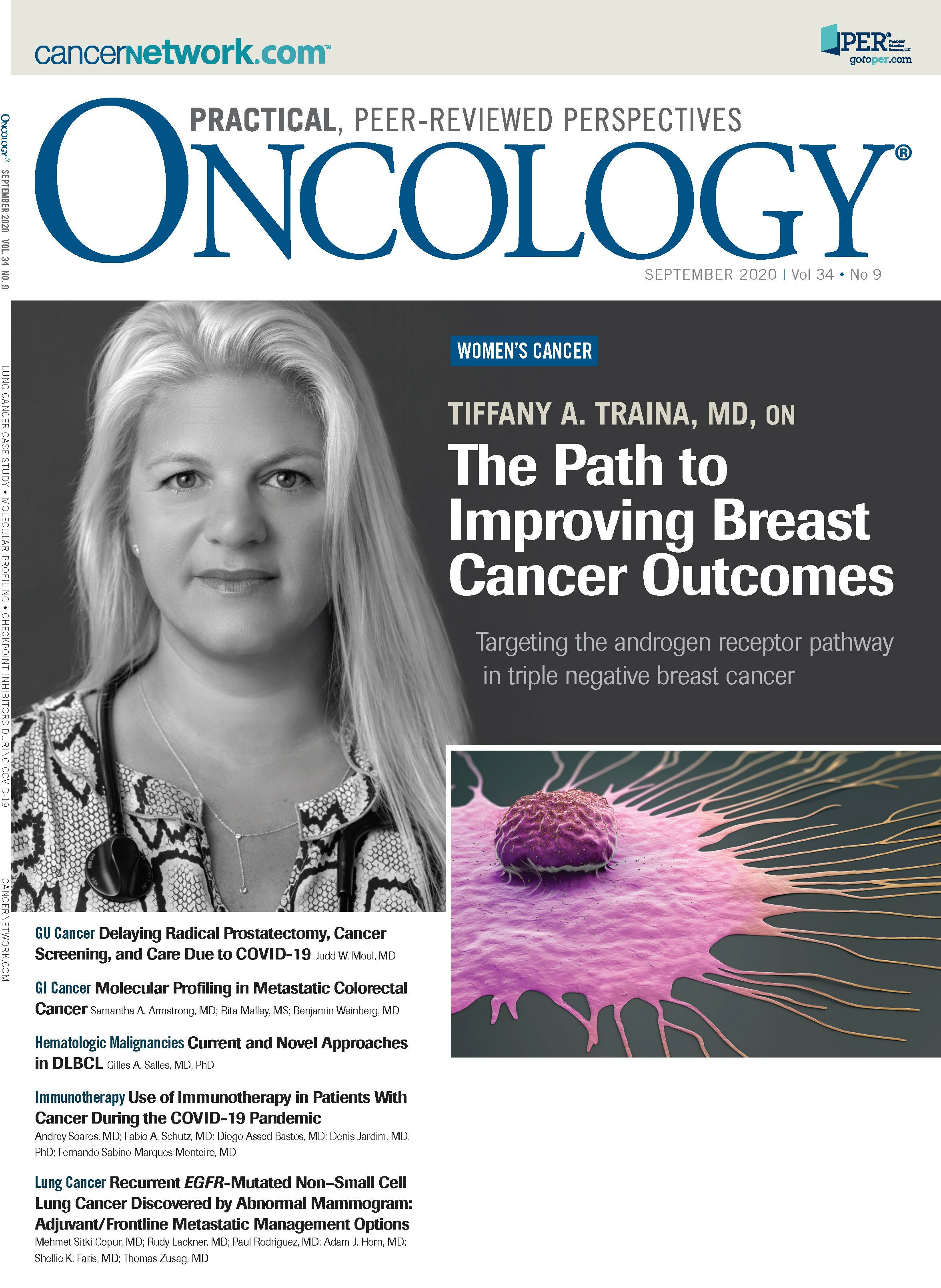The Path to Improving Breast Cancer Outcomes
ONCOLOGY® recently sat down with Tiffany A. Traina, MD, a medical oncologist at Memorial Sloan Kettering Cancer Center, to discuss recent developments in breast cancer care, the upcoming clinical trials that may change the standard of care, and her current work in targeting the androgen receptor pathway for patients with triple-negative breast cancer.
Traina is a medical oncologist at Memorial Sloan Kettering Cancer Center.

With the rise of genetic sequencing and rapidly advancing targeted therapies, outcomes for patients with breast cancer are improving. As the understanding of driver genes and clinical pathways continues to increase, newer treatments for patients with various specific forms of breast cancer are beginning to emerge.
ONCOLOGY® recently sat down with Tiffany A. Traina, MD, a medical oncologist at Memorial Sloan Kettering Cancer Center, to discuss recent developments in breast cancer care, the upcoming clinical trials that may change the standard of care, and her current work in targeting the androgen receptor (AR) pathway for patients with triple-negative breast cancer (TNBC).
Q: What are the most exciting developments going on in breast cancer treatment?
Traina: A few really exciting areas [emerged] in the management of breast cancer over the past year. The first is in the space of treating women with HER2-positive advanced breast cancer. Two new FDA approved agents in that space have really impressive efficacy results. One is a new antibody-drug conjugate, trastuzumab deruxtecan (Enhertu), and the other is an oral tyrosine kinase inhibitor, tucatinib. Tucatinib has shown really promising survival data in patients with brain metastases, which is a tremendous area of unmet need. These 2 powerful new agents will help improve outcomes for our women with advanced HER2-positive breast cancer.
Another area of great interest with new exciting data is in the TNBC space, where we’ve seen FDA approval of a new antibody–drug conjugate called sacituzumab govitecan (Trodelvy). This has really offered hope and promise for patients being treated in the third line or later for TNBC, which is another area of tremendous unmet need, and it really gives us more options for our patients. Additionally, we’re seeing perhaps an expanded role of immunotherapy in TNBC, both in the early-stage setting and in first-line metastatic disease. So, there are a lot of new data to be aware of and also discussions about how to incorporate these new drugs into our practice.
Q: You’ve done a fair amount of work on targeting the AR, even in TNBC. Why is that approach working, and which subset of TNBC patients is it working for?
Traina: That’s a great question. I think what we’ve all come to recognize is that TNBC is quite heterogeneous, and it really is a composite term for tumors that are estrogen-negative, progesterone-negative, and HER2-negative, but they have a constellation of other drivers. Multiple research groups—including ours at MSK—have described a subset of these triple-negative cancers that are driven by an endocrine signature. And it seems to be the presence of the AR, as well as signaling through that AR pathway, that has had compelling evidence of potential benefit from targeting that pathway. So, we’ve led multiple single-arm phase 2 studies of various androgen-targeted oral therapies that are really well tolerated in this specific subset of patients with TNBC. And I’m happy to say that we actually have secured funding and grant support to conduct a randomized trial of the AR antagonist enzalutamide (Xtandi) against treatment of physician’s choice. That particular trial, which will be really rich with correlative studies, will be conducted through the Translational Breast Cancer Research Consortium, and it should be available at sites around the country.
The idea is that for a tumor that’s very endocrine-driven, very hormone-driven, actually targeting that pathway instead of treating with chemotherapy may offer a really well-tolerated approach that could be of benefit. So, rather than adding [a] chemotherapy agent, the idea is that you could lead in with an endocrine approach, and then at some point introduce chemotherapy. It’s not unlike the way we manage an estrogen-driven cancer, using estrogen receptor (ER)-targeted therapies and then ultimately moving those patients to chemotherapy. The design of this clinical trial is such that it could answer that question: Is there a clear subgroup of patients with TNBC who could benefit from a nonchemotherapy approach?
Q: The use of enzalutamide, and similar agents, is typically associated with treating prostate cancer. Will all these agents be considered to treat breast cancer?
Traina: Well, we’ve tried several already. There has been published work using the older and still-available drug bicalutamide (Casodex), as well as work using investigational agents, not yet approved for prostate cancer, that do target the androgen-signaling pathway. Enzalutamide has probably been the one furthest developed, with published mature phase 1 and phase 2 data in breast cancer. So it was natural for that to be the leading agent to leap to a randomized trial right now. Of course, what’s being developed in prostate cancer could also offer promise for our patients with AR-driven breast cancer.
Q: Is targeting the AR pathway a recent development, or is this something that was always known but has only recently come to the forefront?
Traina: The published data on a potential role for targeting the AR pathway really date back more than a decade. However, the relevance of that role is something that’s been more recently clarified. I think we’re still trying to understand the best biomarker to be able to predict for benefit. It may be something beyond just the presence of the receptor, but perhaps more of a composite marker to predict benefit. A lot remains to be understood. Some data show that the AR may be relevant not just in TNBC, but also in ER-positive breast cancer where the coexpression of ER and AR is quite high. In HER2-positive breast cancer, there is also a higher rate of coexpression of the AR and HER2, so we’re still trying to figure out a lot.
Q: You mentioned new applications for immunotherapies in TNBC. What is driving the ability to expand the use of immunotherapies?
Traina: We’ve learned a few things that continue to be clarified around immunotherapy in TNBC. One is learning in which line of therapy these drugs will offer the greatest benefit. We’ve come to see that for metastatic disease, introducing these agents early in the first-line setting shows greater promise than using them in a later line. We are also now seeing, from early-stage trials, that moving these checkpoint inhibitors up into the neoadjuvant setting, even potentially the adjuvant setting, has great benefit. Another piece that we’ve clarified is that as a single agent, each of these drugs has not appeared to be of substantial efficacy, but when they’re partnered with other agents, whether those are cytotoxic chemotherapy or radiation therapy, that’s where we really start to see a big impact from their mechanism of action.
So, over time we’re clarifying [3 questions]: In what line of therapy do you use these drugs? What partners should you use with these drugs? And finally, very important, [can we] refine the predictive biomarker of benefit? The last is still an area that’s a little bit muddy; there are several different definitions for PD-L1 positivity and different companion assays are available, depending on which checkpoint inhibitor you’re talking about. Yet I think we’re seeing greater benefit as we’re better able to define the population who can respond to these agents, and we’re getting better at refining which patients are most likely to benefit [from them].
Q: What trial results are you most looking forward to seeing?
Traina: We haven’t yet touched on the ER-positive space. We’ve seen the press release [describing] the data for the PALLAS trial not meeting its primary end point to show an advantage of palbociclib (Ibrance) in combination of endocrine therapy in the adjuvant setting, and we’ve seen a press release [showing that] abemaciclib (Verzenio) potentially has benefit in the adjuvant setting. Seeing these data in greater detail, to understand how [these agents can] beneficially impact early-stage, ER-positive breast cancer, is something I’m really looking forward to.
Another really important study will include the phase 3 results of trastuzumab deruxtecan in HER2-positive breast cancer. This antibody–drug conjugate had expedited approval based on really amazing efficacy in a single-arm phase 2 study in HER2-positive disease. So, it will be fantastic to see those phase 3 data—likely confirmatory—and also, perhaps, to see some brain data from that agent in HER2-positive breast cancer.
In TNBC, a lot remains to be understood, so [I’m looking forward to] seeing adjuvant data around incorporation of checkpoint inhibitors. Many trials thus far have been neoadjuvant trials with pathologic complete response as the primary end point, but what’s ultimately really important is the survival impact of using these drugs. So those would be some of the highlights I’m really looking forward to that would be practice-changing.
Q: Of the studies in which you’ve participated, which make you most proud?
Traina: I did all of my oncology training at MSK and so being a part of dose density—establishing dose density as a backbone chemotherapy administration schedule—is exciting. I would also say that the entire AR program within TNBC is something I’m really proud of, because that started with an observation by one of our pathologists and really translated into multiple phase 1 studies for women with breast cancer to prove the safety of various agents from [the realm of] prostate cancer. Those moved into phase 2 programs and now I’m really happy to see that [evolve] into a randomized trial. That’s been exciting work to be a part of; seeing the entire drug development, the more than a decade of work to get from observation in the lab at MSK all the way through to a randomized trial. Plus, [I’m proud of being part of] the work in the HER2-positive space and part of the work with trastuzumab deruxtecan. At MSK, we’ve had a part in developing all of the HER2-targeted therapies, really, and it’s so rewarding to get to see highly effective drugs [in the end] and bring them to our patients.
Q: With the coronavirus disease 2019 (COVID-19) pandemic, cancer care and cancer screenings were down. Are we in the recovery phase yet?
Traina: I think we have seen a recovery in volume and clinical volume. But I think what we have recognized, and data are now published to support this, is that in the beginning of the throes of the pandemic, [especially] in March and April, patients were fearful of coming out of their homes, and [especially of] coming into a clinical environment or into congested cities, [or both]. [This was true for] receiving care, and for screening studies, in which the risk–benefit balance in patients’ eyes might have favored avoiding COVID-19 and putting off screening and surveillance studies. A body of literature is developing that suggests we [should be concerned that] we’ll perhaps see a wave of cancer diagnoses at a [later point in time] because of the COVID-19–related delays in diagnosis.
I think we are still very much in the first-wave experience of this pandemic, and [unfortunately] cancer doesn’t just wait. We are now about 5 months into this experience, at least, and in terms of care— whether that means nonelective cancer operations, chemotherapy, immunotherapy, targeted therapy, endocrine therapies—these need to go on, with the care of our patients remaining a priority. We are all finding ways to continue to deliver high-quality care in a safe environment that takes into account social distancing, appropriate personal protective equipment, and psychosocial support, as well as visitor restriction policies and family safety. It really has added layers of complexity to delivering our care, but
it’s necessary.
Financial Disclosure: The authors have no significant financial interest in or other relationship with the manufacturer of any product or provider of any service mentioned in this article.

Late Hepatic Recurrence From Granulosa Cell Tumor: A Case Report
Granulosa cell tumors exhibit late recurrence and rare hepatic metastasis, emphasizing the need for lifelong surveillance in affected patients.
